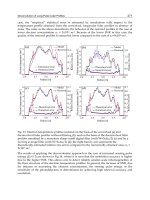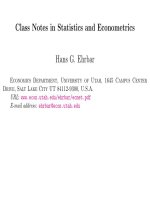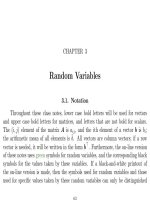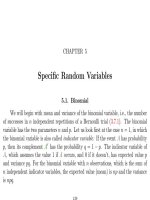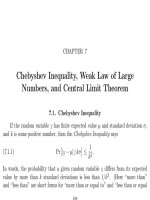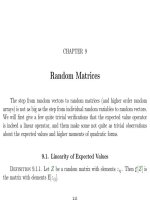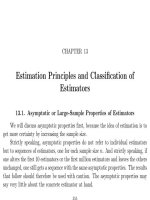Class Notes in Statistics and Econometrics Part 15 pot
Bạn đang xem bản rút gọn của tài liệu. Xem và tải ngay bản đầy đủ của tài liệu tại đây (526.34 KB, 57 trang )
CHAPTER 29
Constrained Least Squares
One of the assumptions for the linear model was that nothing is known about
the true value of β. Any k-vector γ is a possible candidate for the value of β. We
used this assumption e.g. when we concluded that an unbiased estimator
˜
By of β
must satisfy
˜
BX = I. Now we will modify this assumption and assume we know
that the true value β satisfies the linear constraint Rβ = u. To fix notation, assume
y be a n × 1 vector, u a i × 1 vector, X a n × k matrix, and R a i × k matrix.
In addition to our usual assumption that all columns of X are linearly independent
(i.e., X has full column rank) we will also make the assumption that all rows of R
are linearly indep endent (which is called: R has full row rank). In other words, the
matrix of constraints R does not include “redundant” constraints which are linear
combinations of the other constraints.
737
738 29. CONSTRAINED LEAST SQUARES
29.1. Building the Constraint into the Model
Problem 337. Given a regression with a constant term and two explanatory
variables which we will call x and z, i.e.,
(29.1.1) y
t
= α + βx
t
+ γz
t
+ ε
t
• a. 1 point How will you estimate β and γ if it is known that β = γ?
Answer. Write
(29.1.2) y
t
= α + β(x
t
+ z
t
) + ε
t
• b. 1 point How will you estimate β and γ if it is known that β + γ = 1?
Answer. Setting γ = 1 −β gives the regression
(29.1.3) y
t
− z
t
= α + β(x
t
− z
t
) + ε
t
• c. 3 points Go back to a. If you add the original z as an additional regressor
into the modified regression incorporating the constraint β = γ, then t he coefficient
of z is no longer an estimate of the original γ, but of a new parameter δ which is a
linear combination of α, β, and γ. Compute this linear combination, i.e., express δ
29.1. BUILDING THE CONSTRAINT INTO THE MODEL 739
in terms of α, β, and γ. Remark (no proof required): this regression is equivalent to
(29.1.1), and it allows you to test the constraint.
Answer. It you add z as additional regressor into (29.1.2), you get y
t
= α+β(x
t
+z
t
)+δz
t
+ε
t
.
Now substitute the right hand side from (29.1.1) for y to g et α + βx
t
+ γz
t
+ ε
t
= α + β(x
t
+ z
t
) +
δz
t
+ ε
t
. Cancelling out gives γz
t
= βz
t
+ δz
t
, in other words, γ = β + δ. In this regression,
therefore, the coefficient of z is split into the sum of two terms, the first term is the value it should
be if the constraint were satisfied, and the other term is the difference from that.
• d. 2 points Now do the same thing with the modified regression from part b
which incorporates the constraint β + γ = 1: include the original z as an additional
regressor and determine the meaning of the coefficient of z.
What Problem 337 suggests is true in general: every constrained Least Squares
problem can be reduced to an equivalent unconstrained Least Squares problem with
fewer explanatory variables. Indeed, one can consider every least squares problem to
be “constrained” because the assumption
E
[y] = Xβ for some β is equivalent to a
linear constraint on
E
[y]. The decision not to include certain explanatory variables
in the regression can be considered the decision to set certain elements of β zero,
which is the imposition of a constraint. If one writes a certain regression model as
a constrained version of some other regression model, this simply means that one is
interested in the relationship between two nested regressions.
Problem 273 is another example here.
740 29. CONSTRAINED LEAST SQUARES
29.2. Conversion of an Arbitrary Constraint into a Zero Constraint
This section, which is nothing but the matrix version of Problem 337, follows
[DM93, pp. 16–19]. By reordering the elements of β one can write the constraint
Rβ = u in the form
(29.2.1)
R
1
R
2
β
1
β
2
≡ R
1
β
1
+ R
2
β
2
= u
where R
1
is a nonsingular i ×i matrix. Why can that be done? The rank of R is i,
i.e., all the rows are linearly independent. Since row rank is equal to column rank,
there are also i linearly independent columns. Use those for R
1
. Using this same
partition, the original regression can be written
(29.2.2) y = X
1
β
1
+ X
2
β
2
+ ε
ε
ε
Now one can solve (29.2.1) for β
1
to get
(29.2.3) β
1
= R
−1
1
u −R
−1
1
R
2
β
2
Plug (
29.2.3) into (29.2.2) and rearrange to get a regression which is equivalent to
the constrained regression:
(29.2.4) y − X
1
R
−1
1
u = (X
2
− X
1
R
−1
1
R
2
)β
2
+ ε
ε
ε
29.2. CONVERSION OF AN ARBITRARY CONSTR AINT INTO A ZERO CONSTRAINT 741
or
(29.2.5) y
∗
= Z
2
β
2
+ ε
ε
ε
One more thing is noteworthy here: if we add X
1
as additional regressors into
(29.2.5), we get a regression that is equivalent to (29.2.2). To see this, define the
difference between the left hand side and right hand side of (29.2.3) as γ
1
= β
1
−
R
−1
1
u+R
−1
1
R
2
β
2
; then the constraint (29.2.1) is equivalent to the “zero constraint”
γ
1
= o, and the regression
(29.2.6) y −X
1
R
−1
1
u = (X
2
−X
1
R
−1
1
R
2
)β
2
+ X
1
(β
1
−R
−1
1
u + R
−1
1
R
2
β
2
) + ε
ε
ε
is equivalent to the original regression (29.2.2). (29.2.6) can also be written as
(29.2.7) y
∗
= Z
2
β
2
+ X
1
γ
1
+ ε
ε
ε
The coefficient of X
1
, if it is added back into (29.2.5), is therefore γ
1
.
Problem 338. [DM93] assert on p. 17, middle, that
(29.2.8)
R
[X
1
, Z
2
] =
R
[X
1
, X
2
].
where Z
2
= X
2
− X
1
R
−1
1
R
2
. Give a proof.
Answer. We have to show
(29.2.9) {z : z = X
1
γ + X
2
δ} = {z : z = X
1
α + Z
2
β}
742 29. CONSTRAINED LEAST SQUARES
First ⊂: given γ and δ we need a α and β with
(29.2.10) X
1
γ + X
2
δ = X
1
α + (X
2
− X
1
R
−1
1
R
2
)β
This can be accomplished with β = δ and α = γ + R
−1
1
R
2
δ. The other side is even more trivial:
given α and β, multiplying out the right side of (
29.2.10) gives X
1
α + X
2
β − X
1
R
−1
1
R
2
β, i.e.,
δ = β and γ = α − R
−1
1
R
2
β.
29.3. Lagrange Approach to Constrained Least Squares
The constrained least squares estimator is that k ×1 vector β =
ˆ
ˆ
β which mini-
mizes SSE = (y − Xβ)
(y − Xβ) subjec t to the linear constraint Rβ = u.
Again, we assume that X has full c olumn and R full row rank.
The Lagrange approach to constrained least squares, which we follow here, is
given in [Gre97, Section 7.3 on pp. 341/2], also [DM93, pp. 90/1]:
The Constrained Least Squares problem can be solved with the help of the
“Lagrange function,” which is a function of the k ×1 vector β and an additional i×1
vector λ of “Lagrange multipliers”:
(29.3.1) L(β, λ) = (y −Xβ)
(y − Xβ) + (Rβ − u)
λ
λ can be considered a vector of “penalties” for violating the constraint. For every
possible value of λ one computes that β =
˜
β which minimizes L for that λ (This is
an unconstrained minimization problem.) It will turn out that for one of the values
29.3. LAGRANGE APPROACH TO CONSTRAINED LEAST SQUARES 743
λ = λ
∗
, the corresponding β =
ˆ
ˆ
β satisfies the constraint. This
ˆ
ˆ
β is the solution of
the constrained minimization problem we are looking for.
Problem 339. 4 points Show the following: If β =
ˆ
ˆ
β is the unconstrained
minimum argument of the Lagrange function
(29.3.2) L(β, λ
∗
) = (y −Xβ)
(y − Xβ) + (Rβ − u)
λ
∗
for some fixed value λ
∗
, and if at the same time
ˆ
ˆ
β satisfies R
ˆ
ˆ
β = u, then β =
ˆ
ˆ
β
minimizes (y − Xβ)
(y − Xβ) subject to the constraint Rβ = u.
Answer. Since
ˆ
ˆ
β minimizes the Lagrange function, we know that
(y −X
˜
β)
(y −X
˜
β) + (R
˜
β −u)
λ
∗
≥ (y −X
ˆ
ˆ
β)
(y −X
ˆ
ˆ
β) + (R
ˆ
ˆ
β −u)
λ
∗
(29.3.3)
for all
˜
β. Since by assumption,
ˆ
ˆ
β also satisfies the constraint, this simplifies to:
(y −X
˜
β)
(y −X
˜
β) + (R
˜
β −u)
λ
∗
≥ (y −X
ˆ
ˆ
β)
(y −X
ˆ
ˆ
β).(29.3.4)
This is still true for all
˜
β. If we only look at those
˜
β which satisfy the constraint, we get
(y −X
˜
β)
(y −X
˜
β) ≥ (y − X
ˆ
ˆ
β)
(y −X
ˆ
ˆ
β).(29.3.5)
This means,
ˆ
ˆ
β is the constrained minimum argument.
744 29. CONSTRAINED LEAST SQUARES
Instead of imposing the constraint itself, one imposes a penalty function which
has such a form that the agents will “voluntarily” heed the constraint. This is
a familiar principle in neoclassical economics: instead of restricting pollution to a
certain level, tax the polluters so much that they will voluntarily stay within the
desired level.
The proof which follows now not only derives the formula for
ˆ
ˆ
β but also shows
that there is always a λ
∗
for which
ˆ
ˆ
β satisfies R
ˆ
ˆ
β = u.
Problem 340. 2 points Use the simple matrix differentiation rules ∂(w
β)/∂β
=
w
and ∂(β
Mβ)/∂β
= 2β
M to compute ∂L/∂β
where
(29.3.6) L(β) = (y − Xβ)
(y − Xβ) + (Rβ − u)
λ
Answer. Write the objective function as y
y − 2y
Xβ + β
X
Xβ + λ
Rβ − λ
u to get
(29.3.7).
Our goal is to find a
ˆ
ˆ
β and a λ
∗
so that (a) β =
ˆ
ˆ
β minimizes L(β, λ
∗
) and (b)
R
ˆ
ˆ
β = u. In other words,
ˆ
ˆ
β and λ
∗
together satisfy the following two conditions: (a)
they must satisfy the first order condition for the unconstrained minimization of L
with respect to β, i.e.,
ˆ
ˆ
β must annul
(29.3.7) ∂L/∂β
= −2y
X + 2β
X
X + λ
∗
R,
29.3. LAGRANGE APPROACH TO CONSTRAINED LEAST SQUARES 745
and (b)
ˆ
ˆ
β must satisfy the constraint (29.3.9).
(29.3.7) and (29.3.9) are two linear matrix equations which can indeed be solved
for
ˆ
ˆ
β and λ
∗
. I wrote (29.3.7) as a row vector, because the Jacobian of a s calar
function is a row vector, but it is usually written as a column vector. Since this
conventional notation is arithmetically a little simpler here, we will replace (29.3.7)
with its transpose (29.3.8). Our starting point is therefore
2X
X
ˆ
ˆ
β = 2X
y − R
λ
∗
(29.3.8)
R
ˆ
ˆ
β − u = o(29.3.9)
Some textbook treatments have an extra factor 2 in front of λ
∗
, which makes the
math slightly smoother, but which has the disadvantage that the Lagrange multiplier
can no longer be interpreted as the “shadow price” for violating the constraint.
Solve (29.3.8) for
ˆ
ˆ
β to get that
ˆ
ˆ
β which minimizes L for any given λ
∗
:
(29.3.10)
ˆ
ˆ
β = (X
X)
−1
X
y −
1
2
(X
X)
−1
R
λ
∗
=
ˆ
β −
1
2
(X
X)
−1
R
λ
∗
Here
ˆ
β on the right hand side is the unconstrained OLS estimate. Plug this formula
for
ˆ
ˆ
β into (29.3.9) in order to determine that value of λ
∗
for which the corresp onding
746 29. CONSTRAINED LEAST SQUARES
ˆ
ˆ
β satisfies the constraint:
(29.3.11) R
ˆ
β −
1
2
R(X
X)
−1
R
λ
∗
− u = o.
Since R has full row rank and X full column rank, R(X
X)
−1
R
has an inverse
(Problem 341). Therefore one can solve for λ
∗
:
(29.3.12) λ
∗
= 2
R(X
X)
−1
R
−1
(R
ˆ
β − u)
If one substitutes this λ
∗
back into (29.3.10), one gets the formula for the constrained
least squares estimator:
(29.3.13)
ˆ
ˆ
β =
ˆ
β − (X
X)
−1
R
R(X
X)
−1
R
−1
(R
ˆ
β − u).
Problem 341. If R has full row rank and X full column rank, show that
R(X
X)
−1
R
has an inverse.
Answer. Since it is nonnegative definite we have to show that it is positive definite. b
R(X
X)
−1
R
b =
0 implies b
R = o
because (X
X)
−1
is positive definite, and this implies b = o because R has
full row rank.
Problem 342. Assume ε
ε
ε ∼ (o, σ
2
Ψ) with a nonsingular Ψ and show: If one
minimizes SSE = (y −Xβ)
Ψ
−1
(y −Xβ) subject to the linear constraint Rβ = u,
29.3. LAGRANGE APPROACH TO CONSTRAINED LEAST SQUARES 747
the formula for the minimum argument
ˆ
ˆ
β is the following modification of (29.3.13):
(29.3.14)
ˆ
ˆ
β =
ˆ
β − (X
Ψ
−1
X)
−1
R
R(X
Ψ
−1
X)
−1
R
−1
(R
ˆ
β − u)
where
ˆ
β = (X
Ψ
−1
X)
−1
X
Ψ
−1
y. This formula is given in [JHG
+
88, (11.2.38)
on p. 457]. Remark, which you are not asked to prove: this is the best linear unbiased
estimator if ε
ε
ε ∼ (o, σ
2
Ψ) among all linear estimators which are unbiased whenever
the true β satisfies the constraint Rβ = u.)
Answer. Lagrange function is
L(β, λ) = (y −Xβ)
Ψ
−1
(y −Xβ) + (Rβ −u)
λ
= y
y −2y
Ψ
−1
Xβ + β
X
Ψ
−1
Xβ + λ
Rβ −λ
u
Jacobian is
∂L/∂β
= −2y
Ψ
−1
X + 2β
X
Ψ
−1
X + λ
R,
Transposing and setting it zero gives
(29.3.15) 2X
Ψ
−1
X
ˆ
ˆ
β = 2X
Ψ
−1
y −R
λ
∗
Solve (29.3.15) for
ˆ
ˆ
β:
(29.3.16)
ˆ
ˆ
β = (X
Ψ
−1
X)
−1
X
Ψ
−1
y −
1
2
(X
Ψ
−1
X)
−1
R
λ
∗
=
ˆ
β −
1
2
(X
Ψ
−1
X)
−1
R
λ
∗
748 29. CONSTRAINED LEAST SQUARES
Here
ˆ
β is the unconstrained GLS estimate. Plug
ˆ
ˆ
β into the constraint (29 .3.9):
(29.3.17) R
ˆ
β −
1
2
R(X
Ψ
−1
X)
−1
R
λ
∗
− u = o.
Since R ha s full row rank and X full column rank and Ψ is nonsingu lar, R(X
Ψ
−1
X)
−1
R
still
has an inverse. Therefore
(29.3.18) λ
∗
= 2
R(X
Ψ
−1
X)
−1
R
−1
(R
ˆ
β −u)
Now substitute this λ
∗
back into (29.3.16):
(29.3.19)
ˆ
ˆ
β =
ˆ
β −(X
Ψ
−1
X)
−1
R
R(X
Ψ
−1
X)
−1
R
−1
(R
ˆ
β −u).
29.4. Constrained Least Squares as the Nesting of Two Simpler Models
The imposition of a constraint can also be considered the addition of new in-
formation: a certain linear transformation of β, namely, Rβ, is observed without
error.
Problem 343. Assume the random β ∼ (
ˆ
β, σ
2
(X
X)
−1
) is unobserved, but
one observes Rβ = u.
• a. 2 points Compute the best linear predictor of β on the basis of the observation
u. Hint: First write down the joint means and covariance matrix of u and β.
29.4. CONSTRAINED LEAST SQUARES AS THE NESTING OF TWO SIMPLER MODELS 749
Answer.
(29.4.1)
u
β
∼
R
ˆ
β
ˆ
β
, σ
2
R(X
X)
−1
R
R(X
X)
−1
(X
X)
−1
R
(X
X)
−1
.
Therefore application of formula (??) gives
(29.4.2) β
∗
=
ˆ
β + (X
X)
−1
R
R(X
X)
−1
R
−1
(u − R
ˆ
β).
• b. 1 point Look at the formula for the predictor you just derived. H ave you
seen this formula before? Describe the situation in which this formula is valid as a
BLUE-formula, and compare the situation with the situation here.
Answer. Of course, constrained least squares. But in contrained least squares, β is nonrandom
and
ˆ
β is random, while here it is the other way round.
In the unconstrained OLS model, i.e., before the “observation” of u = Rβ, the
best bounded MSE estimators of u and β are R
ˆ
β and
ˆ
β, with the sampling errors
having the following means and variances:
(29.4.3)
u −R
ˆ
β
β −
ˆ
β
∼
o
o
, σ
2
R(X
X)
−1
R
R(X
X)
−1
(X
X)
−1
R
(X
X)
−1
750 29. CONSTRAINED LEAST SQUARES
After the observation of u we can therefore apply (27.1.18) to get exactly equation
(29.3.13) for
ˆ
ˆ
β. This is probably the easiest way to derive this equation, but it derives
constrained least squares by the minimization of the MSE-matrix, not by the least
squares problem.
29.5. Solution by Quadratic Decomposition
An alternative purely algebraic s olution method for this constrained minimiza-
tion problem rewrites the OLS objective function in such a way that one sees imme-
diately what the constrained minimum value is.
Start with the decomposition (18.2.12) which can be used to show optimality of
the OLS estimate:
(y − Xβ)
(y − Xβ) = (y − X
ˆ
β)
(y − X
ˆ
β) + (β −
ˆ
β)
X
X(β −
ˆ
β).
29.5. SOLUTION BY QUADRATIC DECOMPOSITION 751
Split the second term again, using
ˆ
β −
ˆ
ˆ
β = (X
X)
−1
R
R(X
X)
−1
R
−1
(R
ˆ
β −
u):
(β −
ˆ
β)
X
X(β −
ˆ
β) =
β −
ˆ
ˆ
β − (
ˆ
β −
ˆ
ˆ
β)
X
X
β −
ˆ
ˆ
β − (
ˆ
β −
ˆ
ˆ
β)
= (β −
ˆ
ˆ
β)
X
X(β −
ˆ
ˆ
β)
− 2(β −
ˆ
ˆ
β)
X
X(X
X)
−1
R
R(X
X)
−1
R
−1
(R
ˆ
β − u)
+ (
ˆ
β −
ˆ
ˆ
β)
X
X(
ˆ
β −
ˆ
ˆ
β).
The cross pro duct terms can be simplified to −2(Rβ−u)
R(X
X)
−1
R
−1
(R
ˆ
β−
u), and the last term is (R
ˆ
β − u)
R(X
X)
−1
R
−1
(R
ˆ
β − u). Therefore the
objective function for an arbitrary β can be written as
(y − Xβ)
(y − Xβ) = (y − X
ˆ
β)
(y − X
ˆ
β)
+ (β −
ˆ
ˆ
β)
X
X(β −
ˆ
ˆ
β)
− 2(Rβ − u)
R(X
X)
−1
R
−1
(R
ˆ
β − u)
+ (R
ˆ
β − u)
R(X
X)
−1
R
−1
(R
ˆ
β − u)
752 29. CONSTRAINED LEAST SQUARES
The first and last terms do not dep e nd on β at all; the third term is zero whenever
β satisfies Rβ = u; and the second term is minimized if and only if β =
ˆ
ˆ
β, in which
case it also takes the value zero.
29.6. Sampling Properties of Constrained Least Squares
Again, this variant of the least squares principle leads to estimators with desirable
sampling properties. Note that
ˆ
ˆ
β is an affine function of y . We will compute
E
[
ˆ
ˆ
β−β]
and MSE[
ˆ
ˆ
β; β] not only in the case that the true β satisfies Rβ = u, but also in
the case that it does not. For this, let us first get a suitable representation of the
sampling error:
ˆ
ˆ
β − β = (
ˆ
β − β) + (
ˆ
ˆ
β −
ˆ
β) =
= (
ˆ
β − β) −(X
X)
−1
R
R(X
X)
−1
R
−1
R(
ˆ
β − β)(29.6.1)
−(X
X)
−1
R
R(X
X)
−1
R
−1
(Rβ − u).
The last term is
zero if β satisfies the constraint. Now use (24.0.7) twice to get
ˆ
ˆ
β − β = W X
ε
ε
ε−(X
X)
−1
R
R(X
X)
−1
R
−1
(Rβ − u)(29.6.2)
29.6. SAMPLING PROPERTIES OF CONSTRAINED LEAST SQUARES 753
where
W = (X
X)
−1
− (X
X)
−1
R
R(X
X)
−1
R
−1
R(X
X)
−1
.(29.6.3)
If β satisfies the constraint, (29.6.2) simplifies to
ˆ
ˆ
β − β = W X
ε
ε
ε. In this case,
therefore,
ˆ
ˆ
β is unbiased and MSE[
ˆ
ˆ
β; β] = σ
2
W (Problem 344). Since (X
X)
−1
−
W is nonnegative definite, MSE[
ˆ
ˆ
β; β] is smaller than MSE[
ˆ
β; β] by a nonnegative
definite matrix. This should be expected, since
ˆ
ˆ
β uses more information than
ˆ
β.
Problem 344.
• a. Show that W X
XW = W (i.e., X
X is a g-inverse of W ).
Answer. This is a tedious matrix multiplication.
• b. Use this to show that MSE[
ˆ
ˆ
β; β] = σ
2
W .
(Without proof:) The Gauss-Markov theorem can be extended here as follows:
the constrained least squares estimator is the best linear unbiased estimator among
all linear (or, more precisely, affine) estimators which are unbiased whenever the true
β satisfies the constraint Rβ = u. Note that there are more estimators which are
unbiased whenever the true β satisfies the constraint than there are estimators which
are unbiased for all β.
754 29. CONSTRAINED LEAST SQUARES
If Rβ = u, then
ˆ
ˆ
β is biased. Its bias is
(29.6.4)
E
[
ˆ
ˆ
β − β] = −(X
X)
−1
R
R(X
X)
−1
R
−1
(Rβ − u).
Due to the decomposition (23.1.2) of the MSE matrix into dispersion matrix plus
squared bias, it follows
(29.6.5) MSE[
ˆ
ˆ
β; β] = σ
2
W +
+ (X
X)
−1
R
R(X
X)
−1
R
−1
(Rβ − u) ·
· (Rβ − u)
R(X
X)
−1
R
−1
R(X
X)
−1
.
Even if the true parameter does not satisfy the constraint, it is still possible
that the constrained least squares estimator has a better MSE matrix than the
unconstrained one. This is the case if and only if the true parameter values β and
σ
2
satisfy
(29.6.6) (Rβ −u)
R(X
X)
−1
R
)
−1
(Rβ − u) ≤ σ
2
.
This equation, which is the same as [Gre97, (8-27) on p. 406], is an interesting
result, because the obvious estimate of the lefthand side in (29.6.6) is i times the
value of the F-test statistic for the hypothesis Rβ = u. To test for this, one has to
use the noncentral F -test with parameters i, n −k, and 1/2.
29.7. ESTIMATION OF THE VARIANCE IN CONSTRAINED OLS 755
Problem 345. 2 points This Problem motivates Equation (29.6.6). If
ˆ
ˆ
β is a
better estimator of β than
ˆ
β, then R
ˆ
ˆ
β = u is also a better estimator of Rβ than
R
ˆ
β. Show that this latter condition is not only necessary but already sufficient,
i.e., if MSE[R
ˆ
β; Rβ] − MSE[u; Rβ] is nonnegative definite then β and σ
2
satisfy
(29.6.6). You are allowed to use, without proof, theorem A.5.9 in the mathematical
Appendix.
Answer. We have to show
(29.6.7) σ
2
R(X
X)
−1
R
− (Rβ −u)(Rβ − u)
is nonnegative definite. Since Ω
Ω
Ω = σ
2
R(X
X)
−1
R
has an inverse, theorem A.5.9 immed iatel y
leads to (29.6.6).
29.7. Estimation of the Variance in Constrained OLS
Next we will compute the expected value of the minimum value of the constrained
OLS objective funtion, i.e., E[
ˆ
ˆε
ˆ
ˆε] where
ˆ
ˆε = y − X
ˆ
ˆ
β, again without necessarily
making the assumption that Rβ = u:
(29.7.1)
ˆ
ˆε = y −X
ˆ
ˆ
β = ˆε + X(X
X)
−1
R
R(X
X)
−1
R
−1
(R
ˆ
β − u).
756 29. CONSTRAINED LEAST SQUARES
Since X
ˆε = o, it follows
(29.7.2)
ˆ
ˆε
ˆ
ˆε = ˆε
ˆε + (R
ˆ
β − u)
R(X
X)
−1
R
−1
(R
ˆ
β − u).
Now note that
E
[R
ˆ
β −u] = Rβ −u and
V
[R
ˆ
β −u] = σ
2
R(X
X)
−1
R
. Therefore
use (9.2.1) in theorem 9.2.1 and tr
R(X
X)
−1
R
R(X
X)
−1
R
−1
= i to
get
(29.7.3) E[(R
ˆ
β − u)
R(X
X)
−1
R
−1
(R
ˆ
β − u)] =
= σ
2
i+(Rβ − u)
R(X
X)
−1
R
−1
(Rβ − u)
Since E[ˆε
ˆε] = σ
2
(n −k), it follows
(29.7.4) E[
ˆ
ˆε
ˆ
ˆε] = σ
2
(n + i − k)+(Rβ −u)
R(X
X)
−1
R
−1
(Rβ − u).
In other words,
ˆ
ˆε
ˆ
ˆε/(n + i − k) is an unbiased estimator of σ
2
if the constraint
holds, and it is biased upwards if the constraint does not hold. The adjustment of
the degrees of freedom is what one should expect: a regression with k explanatory
variables and i constraints can always be rewritten as a regression with k −i different
explanatory variables (see Section 29.2), and the distribution of the SSE does not
depend on the values taken by the explanatory variables at all, only on how many
29.7. ESTIMATION OF THE VARIANCE IN CONSTRAINED OLS 757
there are. The unbiased estimate of σ
2
is therefore
(29.7.5)
ˆ
ˆσ
2
=
ˆ
ˆε
ˆ
ˆε/(n + i − k)
Here is some geometric intuition: y = X
ˆ
β + ˆε is an orthogonal decomposi-
tion, since ˆε is orthogonal to all columns of X. From orthogonality follows y
y =
ˆ
β
X
X
ˆ
β + ˆε
ˆε. If one splits up y = X
ˆ
ˆ
β +
ˆ
ˆε, one should expect this to be orthog-
onal as well. But this is only the case if u = o. If u = o, one first has to shift the
origin of the coordinate system to a point which can be written in the form Xβ
0
where β
0
satisfies the constraint:
Problem 346. 3 points Assume
ˆ
ˆ
β is the constrained least squares estimate, and
β
0
is any vector satisfying Rβ
0
= u. Show that in the decomposition
(29.7.6) y − Xβ
0
= X(
ˆ
ˆ
β − β
0
) +
ˆ
ˆε
the two vectors on the righthand side are orthogonal.
Answer. We have to show (
ˆ
ˆ
β − β
0
)
X
ˆ
ˆε = 0. Since
ˆ
ˆε = y − X
ˆ
ˆ
β = y −X
ˆ
β + X(
ˆ
β −
ˆ
ˆ
β) =
ˆε + X(
ˆ
β −
ˆ
ˆ
β), and we already know that X
ˆε = o, it is necessary and sufficient to show that
758 29. CONSTRAINED LEAST SQUARES
(
ˆ
ˆ
β −β
0
)
X
X(
ˆ
β −
ˆ
ˆ
β) = 0. By (29.3.13),
(
ˆ
ˆ
β −β
0
)
X
X(
ˆ
β −
ˆ
ˆ
β) = (
ˆ
ˆ
β −β
0
)
X
X(X
X)
−1
R
R(X
X)
−1
R
−1
(R
ˆ
β −u)
= (u − u)
R(X
X)
−1
R
−1
(R
ˆ
β −u) = 0.
If u = o, then one has two orthogonal decompositions: y = ˆy+ ˆε, and y =
ˆ
ˆy +
ˆ
ˆε.
And if one connects the footpoints of these two orthogonal decompositions, one
obtains an orthogonal decomposition into three parts:
Problem 347. Assume
ˆ
ˆ
β is the constrained least squares estimator subject to
the constraint Rβ = o, and
ˆ
β is the unconstrained least squares estimator.
• a. 1 point With the usual notation ˆy = X
ˆ
β and
ˆ
ˆy = X
ˆ
ˆ
β, show that
(29.7.7) y =
ˆ
ˆy + (ˆy −
ˆ
ˆy) + ˆε
Point out these vectors in the reggeom simulation.
Answer. In the reggeom-simulation, y is the purple line; X
ˆ
ˆ
β is the red line starting a t the
origin, one could also call it
ˆ
ˆy; X(
ˆ
β −
ˆ
ˆ
β) = ˆy −
ˆ
ˆy is the light blue line, and ˆε is the green line which
does not start at the origin. In other words: if one projects y on a plane, and also on a line in that
plane, and then connects the footpoints of these two projections, one obtains a zig-zag line with
two right angles.
29.7. ESTIMATION OF THE VARIANCE IN CONSTRAINED OLS 759
• b. 4 points Show that in (29.7.7) the three vectors
ˆ
ˆy, ˆy −
ˆ
ˆy, and ˆε are orthog-
onal. You are allowed to use, without proof, formula (29.3.13):
Answer. One has to verify that the scalar products of the three vectors on the right hand side
of (29.7.7) are zero.
ˆ
ˆy
ˆε =
ˆ
ˆ
β
X
ˆε = 0 and (ˆy −
ˆ
ˆy)
ˆε = (
ˆ
β −
ˆ
ˆ
β)
X
ˆε = 0 follow from X
ˆε = o;
geometrically on can simply say that ˆy and
ˆ
ˆy are in the space spanned by the columns of X, and
ˆε is orthogonal to that space. Finally, using (29.3.13) for
ˆ
β −
ˆ
ˆ
β,
ˆ
ˆy
(ˆy −
ˆ
ˆy) =
ˆ
ˆ
β
X
X(
ˆ
β −
ˆ
ˆ
β) =
=
ˆ
ˆ
β
X
X(X
X)
−1
R
R(X
X)
−1
R
−1
R
ˆ
β =
=
ˆ
ˆ
β
R
R(X
X)
−1
R
−1
R
ˆ
β = 0
because
ˆ
ˆ
β satisfies the constraint R
ˆ
ˆ
β = o, hence
ˆ
ˆ
β
R
= o
.
Problem 348.
• a. 3 points In the model y = β +ε
ε
ε, where y is a n×1 vector, and ε
ε
ε ∼ (o, σ
2
I),
subject to the constraint ι
β = 0, compute
ˆ
ˆ
β,
ˆ
ˆε, and the unbiased est imate
ˆ
ˆσ
2
. Give
general formulas and the numerical results for the case y
=
−1 0 1 2
. All
you need to do is evaluate the appropriate formulas and correctly count the number
of degrees o f freedom.
760 29. CONSTRAINED LEAST SQUARES
Answer. The unconstrained least squares estimate of β is
ˆ
β = y, and since X = I, R = ι
,
and u = 0, the constrained LSE has the form
ˆ
ˆ
β = y − ι(ι
ι)
−1
(ι
y) = y − ι¯y by (29.3.13). If
y
= [−1, 0, 1, 2] this gives
ˆ
ˆ
β
= [−1.5, −0.5, 0.5, 1.5]. The residuals in the constrained model are
therefore
ˆ
ˆε = ι¯y, i.e.,
ˆ
ˆε = [0.5, 0.5, 0.5, 0.5]. Since one has n observations, n parameters and 1
constraint, the number of degrees of freedom is 1. Therefore
ˆ
ˆσ
2
=
ˆ
ˆε
ˆ
ˆε/1 = n¯y
2
which is = 1 in our
case.
• b. 1 point Can you think of a practical situation in which this model might be
appropriate?
Answer. This can occur if one measures data which theoretically add to zero, and the mea-
surement errors are independent and have equal standard deviations.
• c. 2 points Check your results against a SAS printout (or do it in any other
statistical package) with the data vector y
= [
−1 0 1 2
]. Here are the sas commands:
data zeromean;
input y x1 x2 x3 x4;
cards;
-1 1 0 0 0
0 0 1 0 0
1 0 0 1 0
2 0 0 0 1
29.7. ESTIMATION OF THE VARIANCE IN CONSTRAINED OLS 761
;
proc reg;
model y= x1 x2 x3 x4 /
noint;
restrict x1+x2+x3+x4=0;
output out=zerout
residual=ehat;
run;
proc print data=zerout;
run;
Problem 349. Least squares estimates of the coefficients of a linear regression
model often have signs that are regarded by the researcher to be ‘wrong’. In an ef-
fort to obtain the ‘right’ signs, the researcher may be tempted to drop statistically
insignificant variables from the equation. [Lea75] showed that such attempts neces-
sarily fail: there can be no change in sign of any coefficient which is more significant
than the coefficient of the omitted variable. The present exercise shows this, using
a different proof than Leamer’s. You will need the formula for the constrained least
squares estimator subject to one linear constraint r
β = u, which is
(29.7.8)
ˆ
ˆ
β =
ˆ
β − V r
r
V r
−1
(r
ˆ
β − u).

